Sunday, February 6, 2022 - Winter Storms
- Mary Reed

- Feb 6, 2022
- 12 min read
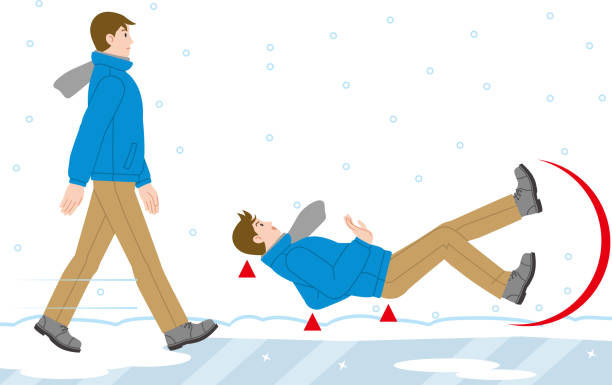
I found out today that a woman who I frequently join in recumbent bike workouts at the gym slipped and fell on the ice recently and is in a rehab center. Winter storms don’t happen very often in Texas. I drove to Tyler last Thursday to stay with friends for one night and had to stay three nights before it was safe enough to drive back home. I kept getting reports from Addison friends about how icy the roads were and the patches of black ice. Waited until the temperature was in the 40s before I drove back home. I have never slipped and fallen on the ice, but have come close. I didn’t have that much snow and ice growing up in Oklahoma. Of course as a kid, I loved snow whenever we got it so I could make a snowman. Didn’t have as far to fall as a child, so was fearless. Famous for the Atkins diet, at age 72 Dr. Robert Atkins slipped and hit his head on an icy New York sidewalk. He underwent surgery to remove a blood clot from his brain, but fell into a coma and died nine days later. Winter storms and ice are nothing to mess around with. Let’s find out more about them.

According to Wikipedia, a winter storm is an event in which wind coincides with varieties of precipitation that only occur at freezing temperatures, such as snow, mixed snow and rain or freezing rain. In temperate continental climates, these storms are not necessarily restricted to the winter season but may occur in the late autumn and early spring as well. A snowstorm with strong winds and other conditions meeting certain criteria is called a blizzard.

Formation
Winter storms are formed when moist air rises up into the atmosphere, creating a low pressure near the ground and clouds up in the air. The air can also be pushed upwards by hills or large mountains. The upward motion is called lift. The moisture is collected by the wind from large bodies of water, such as a big lake or the ocean. If temperature is below freezing or 32 °F, near the ground and up in the clouds, precipitation will fall as snow, ice, rain and snow mixed or sleet, ice pellets or even graupel or soft hail. Since cold air cannot hold as much moisture as warm air, the total precipitation will be less than at higher temperatures.
Winter storm warnings will be issued if:
- Snow accumulation is six inches or more in 12 hours, or eight inches or more in 24 hours.
- Blowing snow is reducing visibility in large areas at winds less than 35 mph.
- Ice accumulations on surfaces are 0.25 inch or more.
- Ice pellets larger than 1 inch are formed.
- Wind chill index is less than −35 °F for more than three hours with sustained wind speed of
at least 10 mph.
Snowstorms with wind speed of more than 35 mph and reduced visibility for 3 hours or more are called blizzards.
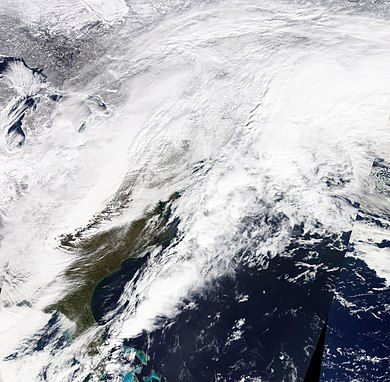
Terminology
Severe winter weather conditions called "winter storms" can be local weather fulfilling the criteria for 24 hours or large storm systems covering part of a continent for several days. With large, massive winter storms, weather in any part of the area covered by the extreme weather is usually called "storm" — even if meteorological criteria for winter storms are not met everywhere. An example of this is the February 13–17, 2021 North American winter storm or Winter Storm Uri with snowfall and below freezing temperatures as far south as Texas and the Gulf of Mexico.

Snowstorm
Snowstorms are storms where large amounts of snow fall. Two inches of snow is enough to create serious disruptions to traffic and school transport because of the difficulty to drive and maneuver the school buses on slick roads. This is particularly true in places where snowfall is not typical but heavy accumulating snowfalls can occur. In places where snowfall is typical, such small snowfalls are rarely disruptive, because of effective snow and ice removal by municipalities, increased use of four-wheel drive and snow tires and drivers being more used to winter conditions. Snowfalls in excess of 6 inches are usually universally disruptive.
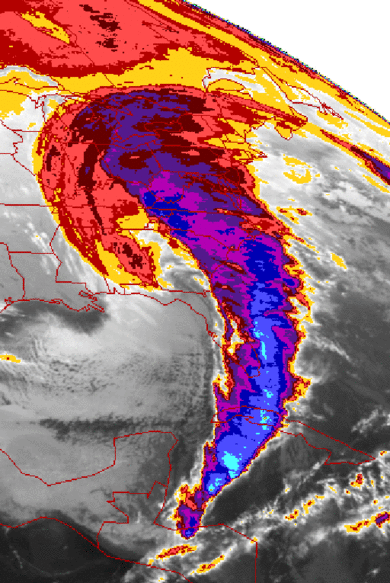
A large number of severe snowstorms — some of which were blizzards — occurred in the United States during 1888 and 1947 as well as the early and mid-1990s. The snowfall of 1947 exceeded 2 feet with drifts and snow piles from plowing that reached 12 feet for months, as temperatures did not rise high enough to melt the snow. The 1993 "Superstorm" or "Storm of the Century" manifested as a blizzard in most of the affected areas.
Severe snowstorms can be quite dangerous: a six-inch snow depth will make some unplowed roads impassable, and it is possible for cars to get stuck in the snow. Snow depth exceeding 12 inches — especially in southern or generally warm climates — will cave the roofs of some homes and cause loss of electricity. Standing dead trees can also be brought down by the weight of the snow, especially if it is wet. Even a few inches of dry snow can form drifts many feet high under windy conditions.
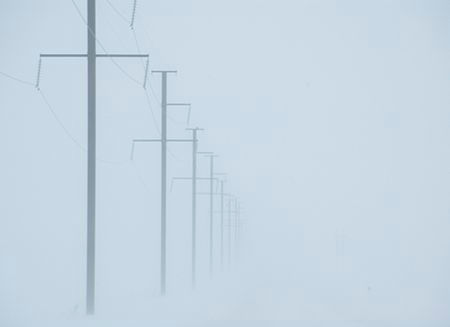
Hazards from snowfall
Accumulated snow can make driving motor vehicles very hazardous. Snow on roadways reduces friction between tires and the road surface, which in turn lowers the maneuverability of a vehicle considerably. As a result, average driving speeds on public roads and highways are reduced by up to 40% while heavy snow is falling. Visibility is reduced by falling snow, and this is further exacerbated by strong winds which are commonly associated with winter storms producing heavy snowfall. In extreme cases, this may lead to prolonged whiteout conditions in which visibility is reduced to only a few feet due to falling or blowing snow. These hazards can manifest even after snowfall has ended when strong winds are present, as these winds will pick up and transport fallen snow back onto roadways and reduce visibility in the process. This can even result in blizzard conditions if winds are strong enough. Heavy snowfall can immobilize a vehicle entirely, which may be deadly depending on how long it takes rescue crews to arrive. The clogging of a vehicle's tailpipe by snow may lead to carbon monoxide buildup inside the cabin.

Depending on the temperature profile in the atmosphere, snow can be either wet or dry. Dry snow, being lighter, is transported by wind more easily and accumulates more efficiently. Wet snow is heavier due to the increased water content. Significant accumulations of heavy, wet snow can cause roof damage. It also requires considerably more energy to move, and this can create health problems while shoveling when combined with the harsh weather conditions. Numerous deaths as a result of heart attacks can be attributed to snow removal. Accretion of wet snow to elevated surfaces occurs when snow is "sticky" enough which can cause extensive tree and power line damage in a manner similar to ice accretion during ice storms. Power can be lost for days during a major winter storm, and this usually means the loss of heating inside buildings. Other than the obvious risk of hypothermia due to cold exposure, another deadly element associated with snowstorms is carbon monoxide poisoning which can happen anytime combustion products from generators or heating appliances are not properly vented. Partially or fully melted snow on roadways can refreeze when temperatures fall, creating black ice.

Freezing rain
Freezing rain is rain maintained at temperatures below freezing by the ambient air mass that causes freezing on contact with surfaces. Unlike a mixture of rain and snow or ice pellets, freezing rain is made entirely of liquid droplets. The raindrops become supercooled while passing through a subfreezing layer of air hundreds of yards above the ground, and then freeze upon impact with any surface they encounter, including the ground, trees, electrical wires, aircraft, and automobiles. The resulting ice, called glaze ice, can accumulate to a thickness of several inches and cover all exposed surfaces.
METAR is a format for reporting weather information. A METAR weather report is predominantly used by aircraft pilots and meteorologists, who use aggregated METAR information to assist in weather forecasting. The METAR code for freezing rain is FZRA.

Freezing rain is often associated with the approach of a warm front, when subfreezing air — temperatures at or below freezing — is trapped in the lowest levels of the atmosphere while warm air advects in aloft. This happens, for instance, when a low pressure system moves from the Mississippi River Valley toward the Appalachian Mountains and the Saint Lawrence River Valley of North America during the cold season, with a strong high pressure system sitting further east. This setup is known as cold-air damming and is characterized by very cold and dry air at the surface within the region of high pressure. The warm air from the Gulf of Mexico is often the fuel for freezing precipitation.
Freezing rain develops when falling snow encounters a layer of warm air aloft, typically around the 800 mbar or 800 hPa level, causing the snow to melt and become rain. As the rain continues to fall, it passes through a layer of subfreezing air just above the surface and cools to a temperature below freezing or 32 °F. If this layer of subfreezing air is sufficiently deep, the raindrops may have time to freeze into ice pellets or sleet before reaching the ground. However, if the subfreezing layer of air at the surface is very shallow, the raindrops falling through it will not have time to freeze, and they will hit the ground as supercooled rain. When these supercooled drops make contact with the ground, power lines, tree branches, aircraft or anything else below 32 °F, a portion of the drops instantly freezes, forming a thin film of ice, hence freezing rain. The specific physical process by which this occurs is called nucleation.

Surface observations by manned or automatic stations are the only direct confirmation of freezing rain. One can never see directly freezing rain, rain or snow on weather radars, Doppler or conventional. However, it is possible to estimate the area covered by freezing rain with radars indirectly.
The intensity of the radar echoes or reflectivity is proportional to the form — water or ice — of the precipitation and its diameter. In fact, rain has much stronger reflective power than snow, but its diameter is much smaller. So, the reflectivity of rain coming from melted snow is only slightly higher. However, in the layer where the snow is melting, the wet flakes still have a large diameter and are coated with water, so the return to the radar is much stronger.
The presence of this brightband indicates that there is a warm layer above ground where snow melts. This could be producing rain on the ground or the possibility of freezing rain, if the temperature is below freezing. This artifact can be located with a cross-section through radar data. The height and slope of the brightband will give clues to the extent of the region where melting occurs. Then it is possible to associate this clue with surface observations and numerical models prediction to produce output such as the ones seen on television weather programs that divide radar echoes into rain, mixed and snow precipitations.
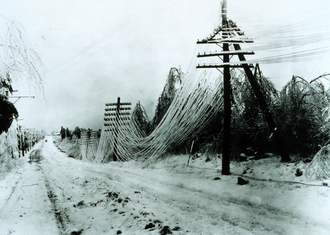
Freezing rain often causes major power outages by forming glaze ice. When the freezing rain or drizzle is light and not prolonged, the ice formed is thin and usually causes only minor damage — relieving trees of their dead branches, etc. When large quantities accumulate, however, it is one of the most dangerous types of winter hazard. When the ice layer exceeds approximately 0.25 inches, tree limbs with branches heavily coated in ice can break off under the enormous weight and fall onto power lines. Windy conditions and lightning, when present, will exacerbate the damage. Power lines coated with ice become extremely heavy, causing support poles, insulators and lines to break. The ice that forms on roadways makes vehicle travel dangerous. Unlike snow, wet ice provides almost no traction, and vehicles will slide even on gentle slopes. Because freezing rain does not hit the ground as an ice pellet called "sleet" but still as a rain droplet, it conforms to the shape of the ground, or object such as a tree branch or car. This makes one thick layer of ice, often called "glaze."
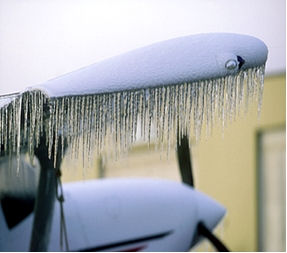
Freezing rain is considered to be an extreme hazard to aircraft, as it causes very rapid structural icing, freezing necessary components. Most helicopters and small airplanes lack the necessary deicing equipment to fly in freezing rain of any intensity, and heavy freezing rain can overwhelm even the most sophisticated deicing systems on large airplanes. Icing can increase an aircraft's weight but not typically enough to cause a hazard. The main danger comes from the ice changing the shape of its airfoils. This will reduce lift and increase drag. All three factors increase stalling speed and reduce aircraft performance, making it very difficult to climb or even maintain altitude.
An aircraft can most easily avoid freezing rain by moving into warmer air. Under most conditions, this would require aircraft to descend, which it can usually do safely and easily even with a moderate accumulation of structural ice. However, freezing rain is accompanied by a temperature inversion aloft, meaning that aircraft are required to climb to move into warmer air, which is a potentially difficult and dangerous task with even a small amount of ice accumulation.

For example, in 1994, American Eagle Flight 4184 encountered heavy air traffic and poor weather that postponed the arrival of this flight at Chicago's O'Hare International Airport, where it was to have landed en route from Indianapolis, Indiana. The ATR-72, a twin-engine turboprop carrying 68 people, entered a holding pattern 65 miles southeast of O'Hare. As the plane circled, supercooled cloud droplets, freezing rain or freezing drizzle formed a ridge of ice on the upper surface of its wings, eventually causing the aircraft's autopilot to suddenly disconnect and the pilots to lose control. The ATR disintegrated on impact with a field below; all passengers and crew were killed.
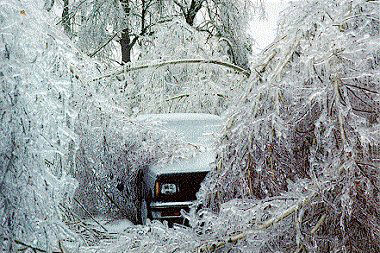
Ice storm
An ice storm is a type of winter storm characterized by freezing rain, also known as a glaze event or, in some parts of the United States, as a silver thaw. The U.S. National Weather Service defines an ice storm as a storm which results in the accumulation of at least 0.25-inch of ice on exposed surfaces. They are generally not violent storms but instead are commonly perceived as gentle rains occurring at temperatures just below freezing.
These storms are notorious for causing travel problems on roadways, breaking tree limbs and downing power lines from the weight of accumulating ice. Downed power lines cause power outages in affected areas, while accumulated ice can also pose significant overhead hazards. It is also known for being extremely dangerous to aircraft since the ice can effectively remold the shape of the airfoil and flight control surfaces.

The freezing rain from an ice storm covers everything with heavy, smooth glaze ice. In addition to hazardous driving or walking conditions, branches or even whole trees may break from the weight of ice. Falling branches can block roads, tear down power and telephone lines and cause other damage. Even without falling trees and tree branches, the weight of the ice itself can easily snap power lines and also break and bring down power/utility poles — even electricity pylons with steel frames. This can leave people without power for anywhere from several days to a month. According to most meteorologists, just one quarter of an inch of ice accumulation can add about 500 pounds of weight per line span. Damage from ice storms is easily capable of shutting down entire metropolitan areas.
Additionally, the loss of power during ice storms has indirectly caused numerous illnesses and deaths due to unintentional carbon monoxide poisoning. At lower levels, CO poisoning causes symptoms such as nausea, dizziness, fatigue and headache, but high levels can cause unconsciousness, heart failure and death. The relatively high incidence of CO poisoning during ice storms occurs due to the use of alternative methods of heating and cooking during prolonged power outages, common after severe ice storms. Gas generators, charcoal and propane barbecues and kerosene heaters contribute to CO poisoning when they operate in confined locations. CO is produced when appliances burn fuel without enough oxygen present, such as basements and other indoor locations.
Loss of electricity during ice storms can indirectly lead to hypothermia and even death from hypothermia. It can also lead to ruptured pipes due to water freezing inside the pipes.
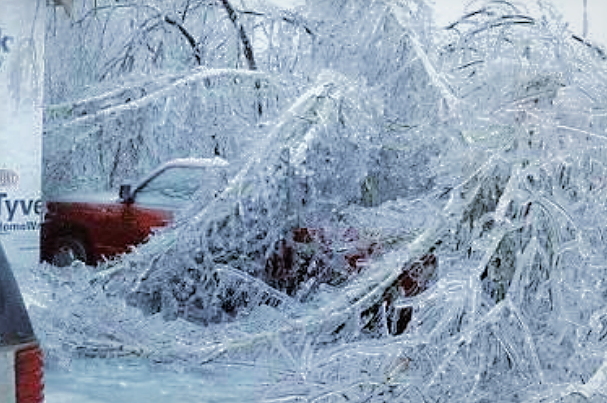
Notable ice storms
Notable ice storms include an El Niño-related North American ice storm of 1998 that affected much of eastern Canada, including Montreal and Ottawa, as well as upstate New York and part of New England. Three million people lost power, some for as long as six weeks. One-third of the trees in Montreal's Mount Royal park were damaged, as well as a large proportion of the sugar-producing maple trees. The amount of economic damage caused by the storm has been estimated at $3 billion in Canadian dollars.

2000 Christmas Day Ice Storm, caused devastating electrical issues in parts of Arkansas, Oklahoma, and Texas. The city of Texarkana, Arkansas experienced the worst damage, at one point losing the ability to use telephones, electricity and running water. In some areas in Arkansas, Oklahoma, Texas and eventually Louisiana, over one inch of ice accumulated from the freezing rain.

2002 North Carolina ice storm resulted in massive power loss throughout much of the state, and property damage due to falling trees. Except in the mountainous western part of the state, heavy snow and icy conditions are rare in North Carolina.
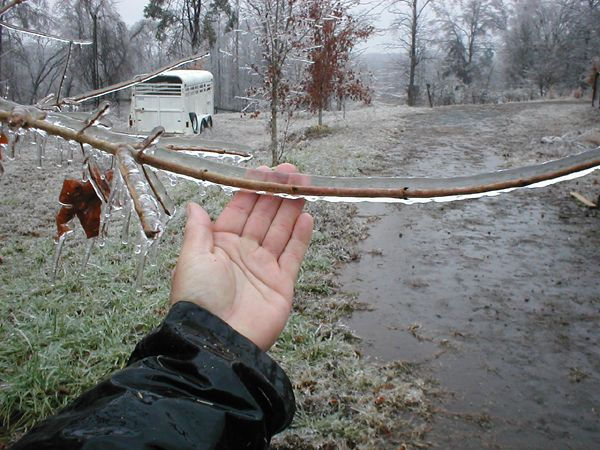
2005 December Ice Storm was another severe winter storm producing extensive ice damage across a large portion of the Southern United States December 14-16. It led to power outages and at least seven deaths.
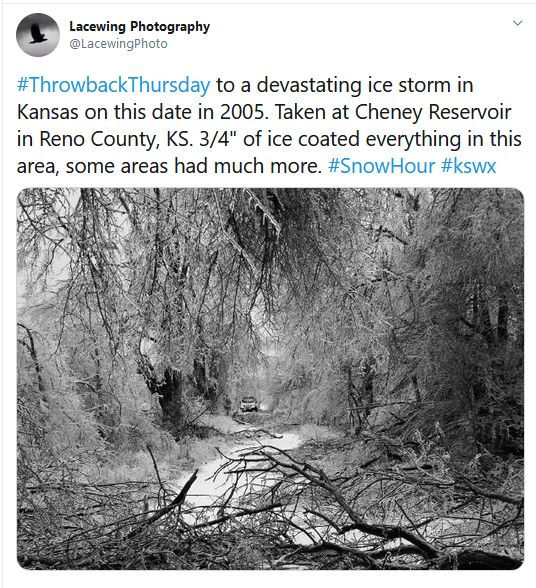
2005 January winter storm in Kansas had been declared a major disaster zone by President George W. Bush after an ice storm caused nearly $39 million in damages to 32 counties. Federal funds were provided to the counties during January 4–6, 2005 to aid the recovery process.
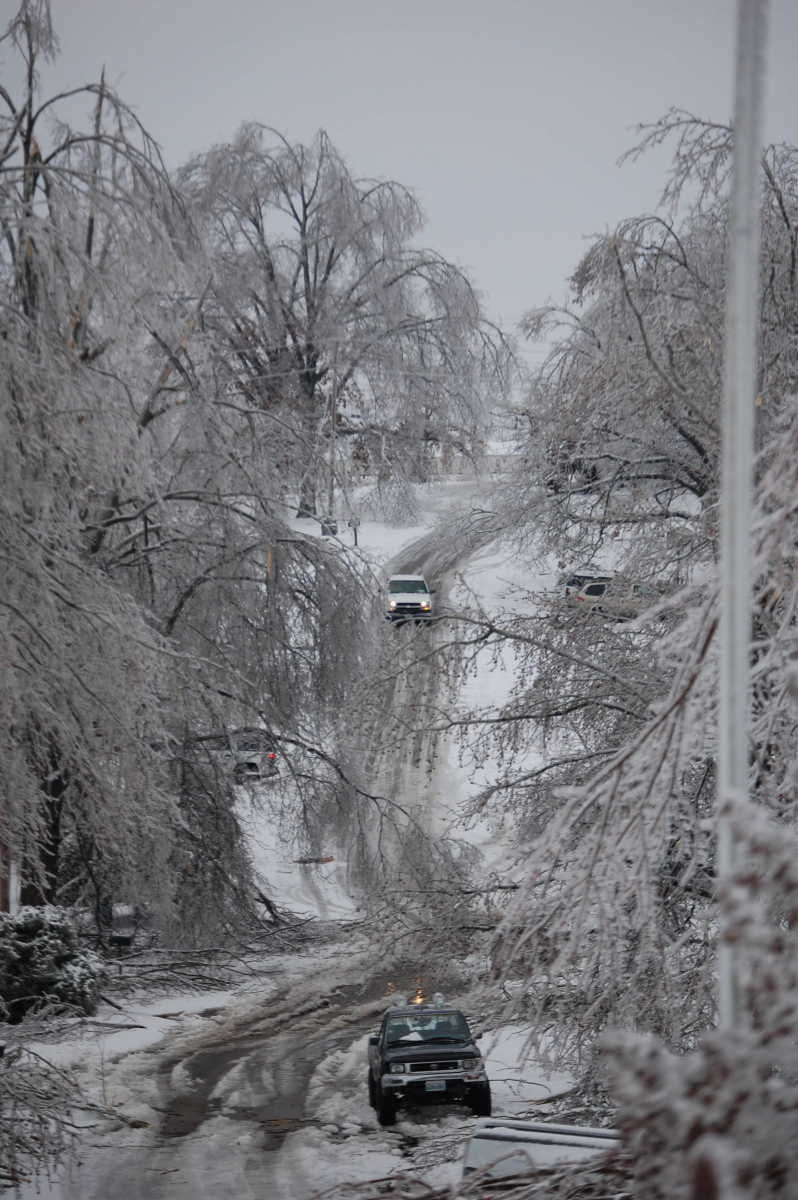
2009 January Central Plains and Midwest ice storm, was a crippling and historic ice storm. Most places struck by the storm, saw two inches or more of ice accumulation, and a few inches of snow on top of it. This brought down power lines, causing some people to go without electricity for a few days to a few weeks. In some cases, electricity was out for a month or more. At the height of the storm, more than 2 million people were without electricity.
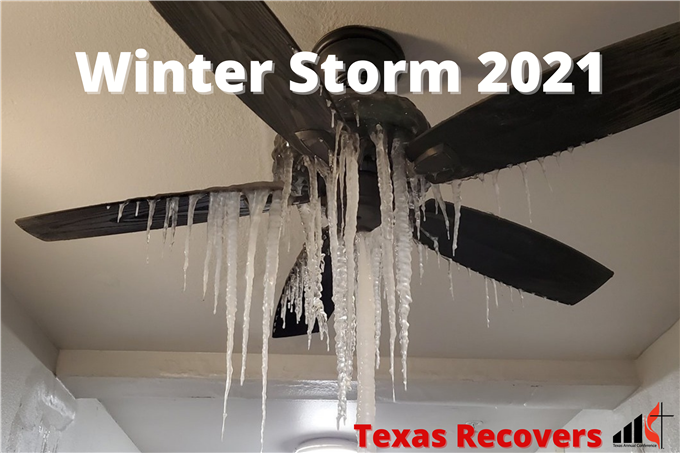
2021 Winter Storm was the deadliest winter storm since the Blizzard of 1996 impacting most of the midwestern and southeastern United States. The state of Texas gained notable publicity due to the failure of the state's power grid, causing blackouts and power outages for 7–10 days across the state. There were 246 people who died.




Comments